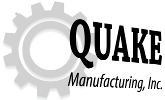CNC Machining: What It Is and How It Works
Introduction
CNC machining is a manufacturing process that uses computerized controls and machine tools to remove layers of material from a blank (or workpiece) and produce a custom part. CNC stands for computer numerical control, and it is a type of subtractive manufacturing, meaning that it creates parts by cutting away unwanted material, rather than adding material layer by layer, as in additive manufacturing (such as 3D printing). CNC machining can be used to create parts from a wide range of materials, such as metals, plastics, wood, glass, foam, and composites, and it can produce parts with high precision, accuracy, and complexity. CNC machining is widely used in various industries, such as aerospace, automotive, medical, defense, and more.

Types of CNC Machines That We Have at Quake Mfg.
There are many types of CNC machines, each with different capabilities and applications. Some of the CNC machines that we have are:
- CNC mills: These machines use a rotating cutting tool, called a milling cutter, to remove material from a workpiece. CNC mills can have multiple axes of motion, allowing them to create complex shapes and features. CNC mills can also be equipped with various attachments, such as drills, taps, and boring tools, to perform different operations on the same workpiece.
- CNC lathes: These machines use a fixed cutting tool to remove material from a rotating workpiece, called a turning blank. CNC lathes can create cylindrical parts, such as shafts, rods, and screws, with high accuracy and surface finish. CNC lathes can also perform other operations, such as threading, knurling, and grooving, by changing the cutting tool or the feed rate.
- Swiss machines: Are a type of CNC machine that are specially designed for producing small and complex parts with high precision and accuracy. They are also known as Swiss type lathes or Swiss automatic lathes. Swiss machines work by feeding a long bar of material through a guide bushing, which supports the material near the point of cutting. The material can rotate and move along the Z-axis, while various tools cut away the features of the part. Swiss machines can perform multiple operations simultaneously in different zones, which reduces the time and waste involved in machining a part. Some examples of products we make on the Swiss machines are screws, pins, plugs, instruments, connectors, and valves. Swiss machines can work with a variety of materials, such as metals, plastics, and composites.
CNC Programming and Software
To control the movement and operation of a CNC machine, a CNC program is required. A CNC program is a set of instructions that tells the CNC machine what to do and how to do it. A CNC program can be written by a person, using a programming language such as G-code or M-code, or generated by a software, using a graphical interface such as CAD (computer-aided design) or CAM (computer-aided manufacturing).

- G-code: This is the most common programming language for CNC machines. It consists of a series of commands that specify the coordinates, feed rate, spindle speed, and tool selection for the CNC machine. For example, G01 X10 Y10 Z10 F100 means move the tool to the position (10, 10, 10) at a feed rate of 100 units per minute.
- M-code: This is a supplementary programming language for CNC machines. It consists of a series of commands that control the auxiliary functions of the CNC machine, such as turning on or off the coolant, spindle, or tool changer. For example, M03 means start the spindle clockwise, and M05 means stop the spindle.
- CAD: This is a software that allows the user to create a 3D model of the part to be machined, using various tools and features. CAD software can also perform analysis and simulation on the 3D model, such as checking for errors, collisions, or stresses. Some examples of CAD software are SolidWorks, AutoCAD, and Fusion 360.
- CAM: This is a software that allows the user to generate a CNC program from the 3D model created by CAD software, using various parameters and strategies. CAM software can also optimize the CNC program for efficiency, quality, and safety. Some examples of CAM software are Mastercam, HSMWorks, and NX.
CNC Machining Advantages
CNC machining has many advantages compared to other manufacturing processes. Some of those are:
- High precision and accuracy: CNC machines can produce parts with tight tolerances and fine details, which are essential for applications that require high performance and reliability.
- High productivity and efficiency: CNC machines can operate continuously and automatically, without human intervention, which reduces labor costs and human errors. CNC machines can also perform multiple operations on the same workpiece, which reduces setup time and waste.
- Higher flexibility and versatility: Swiss machines can create parts with complex shapes and features, which are difficult or impossible to achieve by manual or conventional machining. Swiss machines can also work with a variety of materials, tools, and parameters, which allows for customization and innovation.
Contact us! We do parts for many companies in Fort Wayne and the surrounding areas.
Learn more about us here!
